CARL ZEISS JENA ANTIQUE BRASS JUG-HANDLE MICROSCOPE, STATIV Ic, SN-50881, 1910
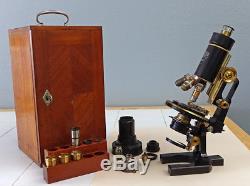
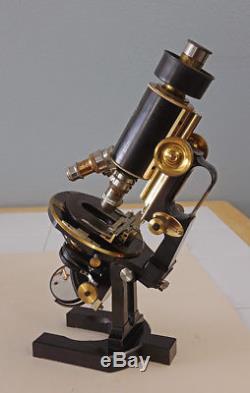
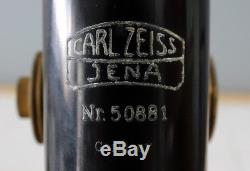

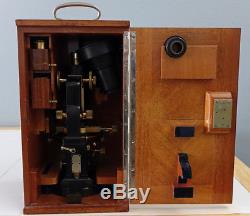

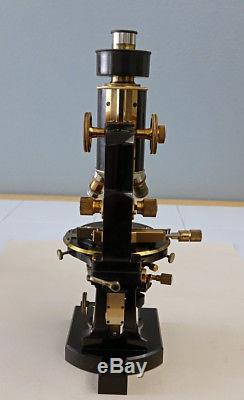
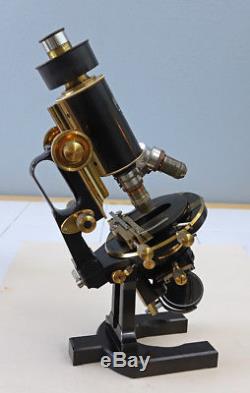
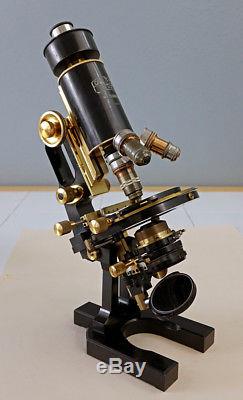
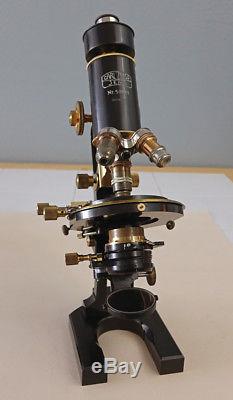
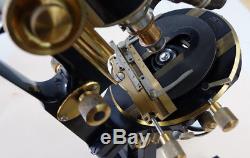


CARL ZEISS JENA ANTIQUE BRASS JUG-HANDLE MICROSCOPE, STATIV Ic, SN-50881, 1910. CARL ZEISS JENA MAGNIFICENT ANTIQUE BRASS JUG-HANDLE PHOTO-MICROGRAPHIC MICROSCOPE, STATIV Ic (STAND Ic), SN 50881 1910. We are very pleased to offer for sale here a superb example of a Carl Zeiss Jena Antique Brass Monocular Compound Jug-Handle Photo-Micrographic Microscope, Stativ Ic or Stand Ic, with a large centerable mechanical stage, a set of three (3) objective lenses, four (4) eyepieces along with photographic accessories and a wood case that houses the instrument. This instrument is signed / engraved on the front face of the body tube, Carl Zeiss Jena, Nr.
The serial number dates the instrument to the year 1910. The Zeiss optical firm manufactured the Stativ I model microscope from about 1898 to 1923.
It features the biggest stand ever offered by the firm up to the year 1898 when it was first introduced. With its very large diameter 50mm body tube and heavy, beefy stand, this microscope was very suitable for a wide variety of microscopical work including photography and micro-projection. Zeiss produced three (3) basic versions or variants of this model, all of which had a complete Abbe illuminating apparatus below the stage with several alternative condensers, but with a different type of stage.
The Stand Ia had a relatively simple revolving and centering vulcanite stage. The Stand Ib had a large revolving and centering mechanical stage and the Stand Ic had a photo-micrographic stage along with a set of accessory fittings for photo-micrographical work including projection. Featured here is a variant of Stativ Ic (Stand Ic) with the large revolving and centering mechanical stage in lieu of the photo-micrographic stage, but with a set of micro-photographic accessories. All three of these Stand I variants featured the now familiar Jug-Handle design in the limb, which was quick to be copied by several other microscope manufacturers, most especially by Bausch & Lomb Optical Co.
Included with this listing is a catalog cut of this very microscope model extracted from the Carl Zeiss Jena Catalogue of Microscopes and Microscopic Accessories, dated 1913. It is provided for comparison purposes with the instrument featured in this listing. The similarities to the listed instrument are readily apparent. However, the featured instrument lacks the photo-micrographic stage shown in the catalogue cut.
Instead it features the large revolving and centering mechanical stage along with a triple revolving objective nosepiece. In essence the listed instrument appears to be a Stand Ib that has been modified into a Stand Ic by the addition of the photographic components.
As noted from the catalogue cut, the factory issued Stand Ic has the letters Ph engraved into the heel of the foot, which the listed instrument does not have. From experience, I have found that such mix/match modifications and nuances in designs are commonly found in all types of antique microscopes. Any of the Carl Zeiss Jena Stativ I variants, be it the Ia, Ib or the Ic, are perhaps the most sought after of the Zeiss antique microscope models from the 1898 to 1923 era. Here is your opportunity to add a very fine example of the Zeiss Stativ Ic to your antique microscope collection. As a part of any antique microscope collection, it is certain to command the center of attention as a real marvel of German craftsmanship, as well as, an instrument that most certainly approaches the pinnacle of superb optical and mechanical engineering and with a net performance that is second to none. This instrument is constructed mostly of black lacquered metal / brass with lacquered brass components and is built upon a heavyweight horseshoe shaped foot of the popular Continental design. A very stout rectangular split pillar rises to a trunnion joint that supports a mostly circular stage plate and, in turn, the rest of the microscope. The trunnion joint allows the instrument to be tilted to any angle from the vertical to horizontal for the comfortable viewing of specimen slides and to facilitate microphotography and/or micro-projection.The position of tilt can be fixed using an arresting lever found at the rear of the instruments stage plate. This microscope is equipped with an elaborate large Zeiss Revolving and Centering Mechanical Stage mounted atop the stage base plate. NOTE: Accompanying this listing is a catalogue cut of this mechanical stage from the 1902 Zeiss Catalogue for comparison with the one found on the microscope. The range of movement of the stage is 50mm (2 inches) in one direction and 35mm (1 3/8 inches) in the other.
A pair of brass milled heads that extend a comfortable distance from the side of the stage control the X-Y movements of the stage. Readings of variations in either direction are taken from scales and verniers attached to the stage.The stage can be rotated almost a full 360 degrees hindered only by the presence of the X-Y control knobs and movement can be arrested with a lock lever found on the right side of the stage. The stage is precisely centered using a pair of brass adjustment screws found on either side of the stage. An adjustable slide retainer is found atop the stage. Under the stage are a very elaborate multi-component swing-out condenser and iris diaphragm assembly mounted on a brass bar extending below the rear of the stage.
This assembly is controlled by a rack and pinion system that allows the assembly to be raised towards or lowered away from the stage using a brass milled head found on the left side of the device. NOTE: A catalogue cut of this unit from the 1902 Zeiss Catalogue is included for comparison with the unit found on the microscope. The Abbe condenser can be swung out and turned aside, which allows a dome shaped iris diaphragm within the condenser holder to control the amount of illumination directed to the stage above. When the Abbe condenser is in place in the light path, another iris diaphragm found in the lower swing-out component can be used to control the amount of light delivered to the condenser for focus on the slide above.
This lower component can also be moved laterally slightly in or out of the light path to provide incident light to the stage. Its movement is controlled by a rack and pinion system found on the side of the component.Completing the substage illumination system is a yoke-mounted 55mm diameter plano-concave mirror assembly found at the distal end of the condenser support bar. Also included with this instrument is an extra E. Leitz Wetzlar darkfield condenser that is equipped with a special adapter that allows it to be used on this Zeiss microscope.
I tested the condenser and it works perfectly. This instrument is equipped with a fat 50mm diameter body tube. The extra wide body tube is another distinguishing characteristic of this model microscope in addition to the Jug-Handle limb.
However, this particular instrument is not fitted with a conventional drawtube as is customarily found on the standard Stands Ia and Ib that I have examined. Rather, it features a relatively short fixed brass ocular holder. Coarse focus is by rack and pinion and fine focus is by means of a unique form of micrometer movement designed by Herr Max Berger, Chief of the Zeiss Jena Construction Office.Zeiss introduced this new fine focus mechanism in 1898 on this model microscope. It is known as Bergers Micrometer Movement. NOTE: A cross sectional diagram of this movement extracted from the 1902 Zeiss Catalogue is included with this listing. In essence, it consists of a pair of milled heads working on an endless screw, which in turn acts on a finely milled spring loaded screw that moves the body tube very slightly up or down. Control is by a pair of milled heads mounted on either side of the limb and under the Jug-Handle.
A vernier scale is found on the left hand knob. One increment on the scale is equal to movement of the body tube by only 0.002mm (see close-up image). At the base of the body tube is a 3-position nickel-plated brass revolving objective nosepiece. A set of three (3) objective lenses are provided: A Zeiss 16mm low power objective; a Zeiss 4mm medium power objective with correction collar; and a Leitz 1/12 high power Oil Immersion objective. A vial of immersion oil is included with the oil immersion objective. Each of these objectives comes with a brass objective vial for storage when not in use on the microscope. The objective vials are accommodated in a pull-out wood rack inside the wood case. Also included with these 3 objectives is an unmarked funnel shaped objective that has no installed glass. Presumably it is used to center the light path for photography or projection. Also included with the microscope is a set of four (4) Zeiss oculars: A Zeiss Compens Okular labeled with the number 12 that is equipped with a measuring reticle; a Zeiss Compens-Okular labeled with the number 18; a Zeiss eyepiece marked with the number 10 and equipped with a needle pointer; and a long barrel Zeiss Compens-Okular labeled with the number 2. This unusual eyepiece may have been designed for eyepiece projection photography.The eyepieces are also stored in a pull-out wood rack inside the wood case when not in use on the microscope. In addition to the components already mentioned, this microscope comes with a set of micro-photography accessories (see accompanying image that shows these items). Included is a concentric ring that fits over the ocular holder. NOTE: This component is visible in the Stand Ic catalogue cut.
Also included is a multi-component part consisting of a wide funnel shaped part with a flat threaded adapter ring that threads into the top of the narrow neck and another high profile threaded adapter that also threads into the neck. I would guess that these items were most likely used for micro-projection. However, I was unable to find any reference to these other components in the Zeiss literature that is in my collection.Perhaps a Zeiss expert out there can identify these parts along with their intended function. When set up for observations, this microscope stands about 14 inches tall.
When the body tube is retracted to its lowest position for storage inside the wood case, the microscope stands about 12 inches tall. This microscope weighs in at 14 pounds a relatively heavy antique brass instrument. Included with this microscope is a very nicely appointed Zeiss Mahogany wood cabinet that houses the instrument and most of the accessories. This case is equipped with a brass carrying handle and has a working lock with key. It appears to be the original case for this instrument.
The exterior dimensions of the wood case are 15 inches tall, 8 inches wide and 8 inches deep. The microscope in its case with the listed accessories weighs 24 pounds. NOTE: The accompanying images are a part of this statement of condition.
Please take the time to view all of the images so you can confirm the condition of the microscope plus its accessories and case and so you will know what you will be getting should you be the very, very fortunate new owner of this fine Zeiss Jena antique precision scientific instrument. In summary, this microscope is in very good to excellent cosmetic, optical and mechanical condition (one of the best I have seen), but with a few relatively minor caveats as noted below. The lacquer on this microscopes brass work is in very good to excellent condition with almost 100% of the original lacquer still present. The lacquered brass parts have a very nice honey-gold patina.However, in concert with the age of the instrument, there are a few spots of tarnish present here and there, mainly on the brass milled heads and on the top of the stage where human body oils tend to accumulate and to provide the chemical catalyst for gradual tarnish over time. The black lacquered brass parts are in very good to excellent condition with a just few very minor scratches, dings and rub marks from use over time. All four of the eyepieces provided with this instrument are in excellent optical condition with no defects evident. The Zeiss 16mm objective is in fair optical condition providing acceptable views, but has a lot of surficial tarnish on the outer barrel.
The Zeiss 4mm objective is in very poor optical condition (does not form an image due to internal fogging). It also is cosmetically tarnished. The Leitz 1/12 objective appears to be in excellent optical and cosmetic condition, although it was not tested for optical performance. Both the Zeiss Abbe condenser and the extra Leitz darkfield condenser are free of any optical defects.
The plano-concave mirror is in excellent condition with no evidence of any loss of silvering. Both sides of the mirror provide good illumination to the stage. The mechanics associated with this microscope are in very good to excellent condition.Both the coarse and fine focus mechanisms work smoothly and perfectly as designed. The mechanics associated with the substage illumination system work perfectly. The x-y movements of the stage work smoothly and precisely. The stage rotates freely throughout its range and its centering and arresting mechanisms work as they should.
Both of the iris diaphragms in the substage apparatus work properly and the vanes are free of any tarnish. In summary, this instrument has evidently been well cared for over the years and, if desired, still can be used for serious microscopic investigations to this day a testimony to the manufacturers superb attention to detail and a marvel of German engineering at its best.
We will also entertain REASONABLE offers for this superb microscope. FREE scheduling, supersized images and templates. Make your listings stand out with FREE Vendio custom templates!
Over 100,000,000 served. Get FREE counters from Vendio today! The item "CARL ZEISS JENA ANTIQUE BRASS JUG-HANDLE MICROSCOPE, STATIV Ic, SN-50881, 1910" is in sale since Wednesday, June 20, 2018. This item is in the category "Collectibles\Science & Medicine (1930-Now)\Scientific Instruments\Microscopes, Lab Equipment". The seller is "mtloggera" and is located in Hamilton, Montana.
This item can be shipped worldwide.
- Antique Brass Microscope: Stativ Ic Jug-Handle Microscope
- Country of Manufacture: Germany
- Manufacturer: Carl Zeiss Jena
- Product Type: Microscopes, Lab Equipment

